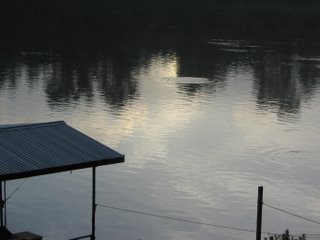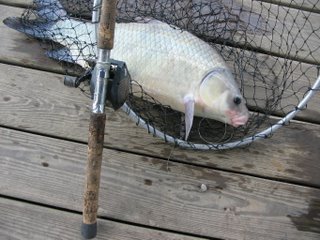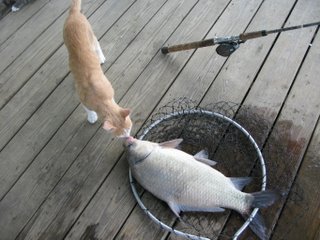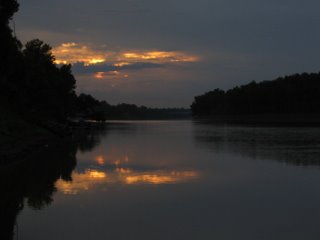Mullet, Napoleon and Beavers

Tonight there are storms coming in off of the Gulf due to a disturbance that is not tropical, they say. Still, they call these storms rain bands, and after last year that’s enough to make you nervous. But the heavy clouds at sunset tonight are pretty, and the breaks between them are really bright in contrast – like hope in the darkness.
 Some postings ago I mentioned that schools of mullet were the main thing that helped consume the decomposing alligator. This was just out of character, as my understanding of mullet behavior existed at the time. Today a bunch of them were doing more what you expect, grazing on plant material. In this case, the plant material was pollen and algae drifting along on top of the river and collecting as a floating mat in front of the dock. You can see it just below the cat. The fish were coming to the surface and vacuuming the floating green material. They make a strange sort of popping sound when they feed on the surface like that, not like when they are caught in low-oxygen water and are “piping” on top to get some relief. When they do that they don’t make much of a sound at all. Napoleon was attracted to the movement and sounds in the
Some postings ago I mentioned that schools of mullet were the main thing that helped consume the decomposing alligator. This was just out of character, as my understanding of mullet behavior existed at the time. Today a bunch of them were doing more what you expect, grazing on plant material. In this case, the plant material was pollen and algae drifting along on top of the river and collecting as a floating mat in front of the dock. You can see it just below the cat. The fish were coming to the surface and vacuuming the floating green material. They make a strange sort of popping sound when they feed on the surface like that, not like when they are caught in low-oxygen water and are “piping” on top to get some relief. When they do that they don’t make much of a sound at all. Napoleon was attracted to the movement and sounds in the  water. I truly believe that he could be taught to dive in and catch (or try to) fish for himself, provided they were near the top of the river like these mullet were. He gets up and does that rear-end-wiggle that cats do before they leap at a prey item. It wouldn’t take much. I’m always tempted when he isn’t paying attention like that, to just kind of help him overboard, but no, I won’t. One picture shows the school of fish just as they notice the cat and panic. The other one just shows the school.
water. I truly believe that he could be taught to dive in and catch (or try to) fish for himself, provided they were near the top of the river like these mullet were. He gets up and does that rear-end-wiggle that cats do before they leap at a prey item. It wouldn’t take much. I’m always tempted when he isn’t paying attention like that, to just kind of help him overboard, but no, I won’t. One picture shows the school of fish just as they notice the cat and panic. The other one just shows the school.Another animal that is easy to see at the river right now is the set of beavers that live around here somewhere. They are always doing something interesting at night, and as long as that something isn’t chewing my dock or ropes, it’s OK. Right now they are grazing in the thick growth of cocklebur along the banks. Every year we get this almost pure stand of cocklebur that grows from the waterline at low water to about 20 feet up the bank (the bluegreen plants on the left below). The beavers just wade out of the river and walk into the thick growth and begin making these munching sounds. You can almost see those big teeth gnashing their way through the hard stems on the plants. The other food you see them eating is willow bark, of course, and the evidence is all over the river in the form of white sticks floating down the current. The beavers do me a favor and then take it away sometimes. They ring, or p
 artially cut, big willows across the river and these trees die and make wonderful places to see birds (hawks and kites mostly) as they sit up high in the dead branches. But the beavers eventually finish cutting the trees and the birds move to some other place on the river, sometimes nearby and sometimes not. Right now the ospreys that used to sit on snags across the river in easy view have moved to some other place. The snags they used to use near here have fallen. But I have faith in the beavers, they are probably out there killing new trees for me as I write this.
artially cut, big willows across the river and these trees die and make wonderful places to see birds (hawks and kites mostly) as they sit up high in the dead branches. But the beavers eventually finish cutting the trees and the birds move to some other place on the river, sometimes nearby and sometimes not. Right now the ospreys that used to sit on snags across the river in easy view have moved to some other place. The snags they used to use near here have fallen. But I have faith in the beavers, they are probably out there killing new trees for me as I write this.The river is at 3.3 feet now on the Butte La Rose gauge, going to 3.0 by Thursday. The Ohio and Mississippi are a little up and a little down, kind of staying in place overall.
Rise and Shine, Jim




















